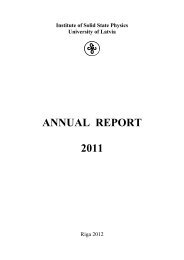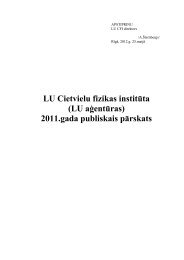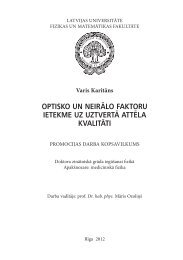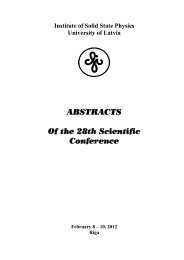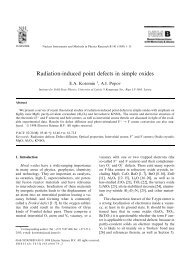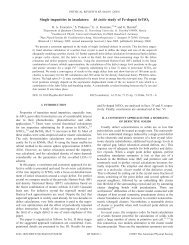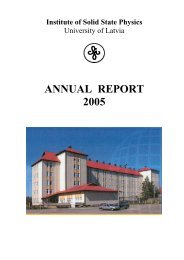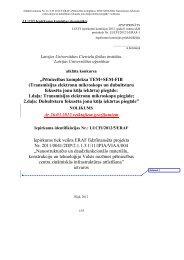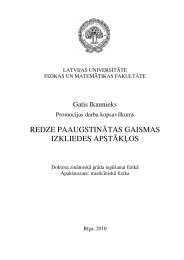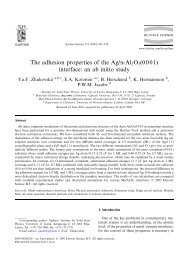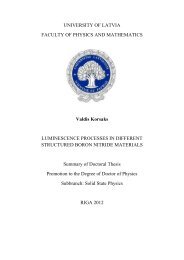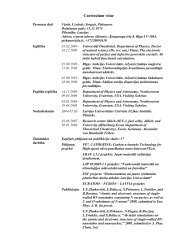Annual Report 2012 - Latvijas Universitātes Cietvielu fizikas institūts
Annual Report 2012 - Latvijas Universitātes Cietvielu fizikas institūts
Annual Report 2012 - Latvijas Universitātes Cietvielu fizikas institūts
You also want an ePaper? Increase the reach of your titles
YUMPU automatically turns print PDFs into web optimized ePapers that Google loves.
BIFURCATION ANALYSIS IN A 3D SYSTEM MODELING OSCILLATING<br />
PHENOMENA IN FUSION PLASMA PHYSICS<br />
O. Dumbrajs,<br />
D. Constantinescu,<br />
Dept of Applied Mathematics, University of Craiova, Romania<br />
V. Igochine, K. Lackner, H. Zohm<br />
Max-Planck Institut für Plasmaphysik, Garching, Germany<br />
The aim of this paper was a study of a 3D dynamical system which models some<br />
instabilities that occur in fusion plasma experiments in TOKAMAKs (toroidal devices<br />
for obtaining energy through controlled thermonuclear fusion). This model depends on<br />
three parameters. It was formulated for the description of a system with drive and<br />
relaxation processes which have different time scales. It has some properties analogue to<br />
Lorenz system, but it does not belong to the family of Lorenz-like systems. We<br />
systematically study the dynamics of the system for various values of the parameters and<br />
we provide analytical results concerning some bifurcations that occur in the parameters<br />
space. We theoretically analyze the fast-slow dynamics of the system and we apply the<br />
results in some situations which correspond to experimental data obtained in ASDEX-<br />
Upgrade tokamak.<br />
Fig.18. Bifurcation diagram for a fixed values of δ=0.2, η=0.2, pitchfork bifurcation<br />
(labelled A) in h=1, two pairs of Hopf bifurcations (labelled B, -B respectively C, -C) in<br />
h 1 and h 2 , homoclinic bifurcation in h 0 .<br />
ANALYSIS OF AFTERCAVITY INTERACTION IN EUROPEAN ITER<br />
GYROTRONS AND IN THE COMPACT SUB-THZ GYROTRON FU CW-CI<br />
O. Dumbrajs<br />
T. Idehara<br />
Research Center for Development of FI Region, University of Fukui (FIR FU), Japan<br />
Possibilities of arising of aftercavity interaction are analyzed in the ITER 170 GHz 2<br />
MW coaxial cavity gyrotron and the 170 GHz 1 MW cylindrical cavity gyrotron, as<br />
well as in the compact 394.5 GHz low power gyrotron FU CW-CI. Also, the simulations<br />
for the gyrotron efficiency in the presence of aftercavity interaction are performed in the<br />
cold cavity approximation. Results of the analysis illustrate the subtle interplay between<br />
the geometry of the output taper and the profile of the magnetic field.<br />
72



